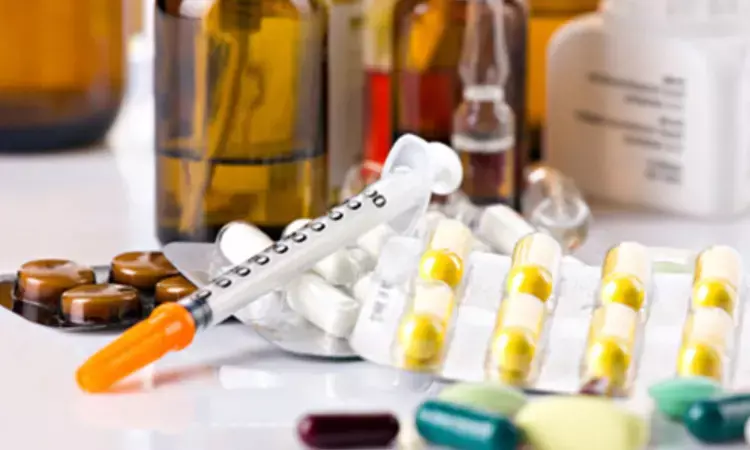- Home
- Medical news & Guidelines
- Anesthesiology
- Cardiology and CTVS
- Critical Care
- Dentistry
- Dermatology
- Diabetes and Endocrinology
- ENT
- Gastroenterology
- Medicine
- Nephrology
- Neurology
- Obstretics-Gynaecology
- Oncology
- Ophthalmology
- Orthopaedics
- Pediatrics-Neonatology
- Psychiatry
- Pulmonology
- Radiology
- Surgery
- Urology
- Laboratory Medicine
- Diet
- Nursing
- Paramedical
- Physiotherapy
- Health news
- Fact Check
- Bone Health Fact Check
- Brain Health Fact Check
- Cancer Related Fact Check
- Child Care Fact Check
- Dental and oral health fact check
- Diabetes and metabolic health fact check
- Diet and Nutrition Fact Check
- Eye and ENT Care Fact Check
- Fitness fact check
- Gut health fact check
- Heart health fact check
- Kidney health fact check
- Medical education fact check
- Men's health fact check
- Respiratory fact check
- Skin and hair care fact check
- Vaccine and Immunization fact check
- Women's health fact check
- AYUSH
- State News
- Andaman and Nicobar Islands
- Andhra Pradesh
- Arunachal Pradesh
- Assam
- Bihar
- Chandigarh
- Chattisgarh
- Dadra and Nagar Haveli
- Daman and Diu
- Delhi
- Goa
- Gujarat
- Haryana
- Himachal Pradesh
- Jammu & Kashmir
- Jharkhand
- Karnataka
- Kerala
- Ladakh
- Lakshadweep
- Madhya Pradesh
- Maharashtra
- Manipur
- Meghalaya
- Mizoram
- Nagaland
- Odisha
- Puducherry
- Punjab
- Rajasthan
- Sikkim
- Tamil Nadu
- Telangana
- Tripura
- Uttar Pradesh
- Uttrakhand
- West Bengal
- Medical Education
- Industry
Which second-line antihyperglycemic drugs are most effective for lowering CKD risk?

Thailand: A recent study published in Cardiovascular Diabetology has compared the treatment effectiveness of sodium-glucose cotransporter-2 inhibitors (SGLT2i) on renal outcomes with other second-line drugs (sulfonylureas (SU), thiazolidinediones (TZD), dipeptidyl peptidase-4 inhibitors (DPP4i)).
Real-world clinical data showed that Thai patients with type 2 diabetes treated with SGLT2i were at 9.5%, 13.7%, and 14.2% reduced risk of chronic kidney disease (CKD) versus those treated with DPP4i, TZD, and SU, respectively. The authors stated their findings in the Southeast Asian cohort were consistent with prior evidence of a reno-protective effect of SGLT2 inhibitors reported in other populations.
Thitiya Lukkunaprasit, Rangsit University, Pathum Thani, Thailand, and colleagues stated, "although clinical trials have assessed the renoprotective effect of second-line treatment in type 2 diabetes, their generalizability to routine clinical practice is still uncertain." To fill this knowledge gap, they aimed to investigate the effectiveness of these treatments, in addition to metformin, on the CKD risk.
For this purpose, the researchers assembled a real-world, hospital-based, type 2 diabetes cohort at Ramathibodi Hospital. The study included patients treated with thiazolidinediones, dipeptidyl peptidase-4 inhibitors, sulfonylureas, or sodium-glucose cotransporter-2 inhibitors as second-line antihyperglycemic treatment. CKD risk according to the treatment was estimated.
The study led to the following findings:
· The researchers identified CKD in 4,132 of the 24,777 type 2 diabetes patients (16.7%).
· For type 2 diabetes patients receiving SGLT2i, DPP4i, TZD, and SU treatments, the incidence of CKD was 4.1%, 13.5%, 14.8%, and 18.0%, respectively.
· The average treatment effects (defined as the difference in the risk of CKD) for SGLT2i, DPP4i, and TZD versus SU were − 0.142, − 0.046, and − 0.004 suggesting a significant reduction in the risk of chronic kidney disease of 4.6% and 14.2% in the DPP4i and SGLT2i groups, respectively versus the SU group.
· SGLT2i significantly reduced CKD risk by 13.7% and 9.5% compared to TZD and DPP4i, respectively.
"The findings from the real-world clinical data revealed 14.2%, 13.7%, and 9.5% reduced risk of CKD in Thai type 2 diabetes patients treated with SGLT2i compared to the treatment with SU, TZD, and DPP4i, respectively," the researchers wrote.
"Previous evidence of a reno-protective effect of SGLT2 inhibitors reported in other people is consistent with our observations in this Southeast Asian cohort," they concluded.
Reference:
Siriyotha, S., Lukkunaprasit, T., Looareesuwan, P. et al. Effects of second-line antihyperglycemic drugs on the risk of chronic kidney disease: applying a target trial approach to a hospital-based cohort of Thai patients with type 2 diabetes. Cardiovasc Diabetol 21, 248 (2022). https://doi.org/10.1186/s12933-022-01641-2
Dr Kamal Kant Kohli-MBBS, DTCD- a chest specialist with more than 30 years of practice and a flair for writing clinical articles, Dr Kamal Kant Kohli joined Medical Dialogues as a Chief Editor of Medical News. Besides writing articles, as an editor, he proofreads and verifies all the medical content published on Medical Dialogues including those coming from journals, studies,medical conferences,guidelines etc. Email: drkohli@medicaldialogues.in. Contact no. 011-43720751


